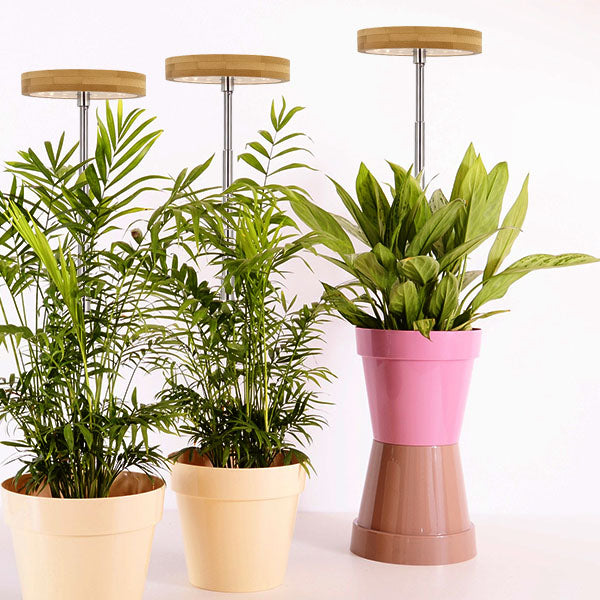The Future of Plant Lights: Exploring Emerging Trends and Market Opportunities

In recent years, plant lights have become increasingly popular among indoor gardeners, plant enthusiasts, and commercial growers. With advancements in LED technology and the growing demand for sustainable and eco-friendly farming practices, the market for plant lights is projected to grow significantly in the coming years. In this blog post, we'll explore some of the emerging trends and market opportunities in the plant light industry.

Section 1: The Benefits of Plant Lights
1.Increasing plant growth and yield
Plant lights provide a consistent and controlled source of light that can stimulate photosynthesis and growth in plants. By providing the right amount of light at the right time, plant lights can help increase plant productivity and yield, leading to higher profits for growers.
2.Extending the growing season
With plant lights, growers can extend the growing season beyond what is possible with natural sunlight alone. This is especially important for regions with short growing seasons or limited sunlight. By using plant lights, growers can produce fresh, local produce year-round, even in areas with harsh weather conditions.
3.Reducing water consumption:
Plant lights can help reduce water consumption in indoor farming systems by optimizing plant growth and reducing water evaporation. In traditional outdoor farming, water is often wasted due to evaporation, runoff, and inefficient irrigation systems. Plant lights can help minimize these issues and lead to more sustainable water usage.
4.Providing optimal light conditions for different plant species
Different plant species have different light requirements for growth and development. With plant lights, growers can customize the light

Section 2: Emerging Trends in Plant Lights
1.Smart plant lights with built-in sensors and automation features:
These types of plant lights use sensors to detect environmental conditions such as temperature, humidity, and CO2 levels. They can then adjust the light intensity and spectrum to optimize plant growth and health. Some smart plant lights also have automation features, allowing growers to remotely control the lights and monitor plant growth.
2.Full-spectrum LED lights that mimic natural sunlight
Full-spectrum LED lights are designed to mimic the spectrum of natural sunlight, which is important for plant growth and development. By using full-spectrum LED lights, growers can provide the right type of light that plants need to grow and thrive.
3.UV LED lights for disease prevention and plant health
UV LED lights emit ultraviolet radiation, which can help prevent the spread of plant diseases and improve plant health. They can also stimulate the production of certain compounds in plants that can enhance flavor and nutritional value.
4.Wireless and portable plant lights for easy mobility
Wireless and portable plant lights are designed for growers who need to move their plants around frequently or have limited space. These types of plant lights are lightweight and easy to move, making them ideal for home gardeners, apartment dwellers, and small-scale commercial growers.
5.Vertical farming systems that integrate plant lights for maximum efficiency
Vertical farming systems use stacked layers of plants to maximize growing space and efficiency. By integrating plant lights into the vertical farming system, growers can optimize plant growth and yield, while minimizing energy and water usage. Vertical farming systems are especially useful for urban farming and indoor agriculture, where space is limited.

Section 3: Market Opportunities for Plant Lights
1.Home gardening and urban farming:
Plant lights are ideal for home gardeners and urban farmers who want to grow fresh produce in limited space or in areas with limited access to natural sunlight. By using plant lights, home gardeners can grow a variety of plants, including vegetables, herbs, and flowers, indoors or on a balcony. Urban farmers can use plant lights to grow crops on rooftops or in abandoned buildings, providing fresh produce to local communities.
2.Commercial greenhouse and hydroponic operations
Plant lights are widely used in commercial greenhouse and hydroponic operations, where crops are grown in a controlled environment. By using plant lights, growers can optimize plant growth and yield, while minimizing energy and water usage. Commercial growers can produce crops year-round, regardless of weather conditions, and can offer a wide variety of crops to consumers.
3.Indoor farming for food and medicinal crops
Indoor farming is an emerging field that uses plant lights to grow food and medicinal crops in a controlled environment. This method of farming is especially useful in areas with limited access to natural resources, such as water and land. Indoor farming can also reduce the risk of pests and diseases that are common in traditional outdoor farming.
4.Research and development for new plant species and applications
Plant lights are also used in research and development to study plant biology, genetics, and physiology. Researchers can use plant lights to create specific light conditions to test the effects of different wavelengths of light on plant growth and development. They can also use plant lights to develop new plant species that are better suited for specific growing conditions or applications, such as medicinal plants or crops for space exploration.

In conclusion, plant lights are poised to become a key component of modern agriculture and sustainable food production. As the demand for fresh, locally-grown produce continues to rise, plant lights offer a viable solution for growers of all sizes and scales. By staying abreast of emerging trends and market opportunities, businesses and individuals can capitalize on the growing demand for plant lights and contribute to a more sustainable future.
